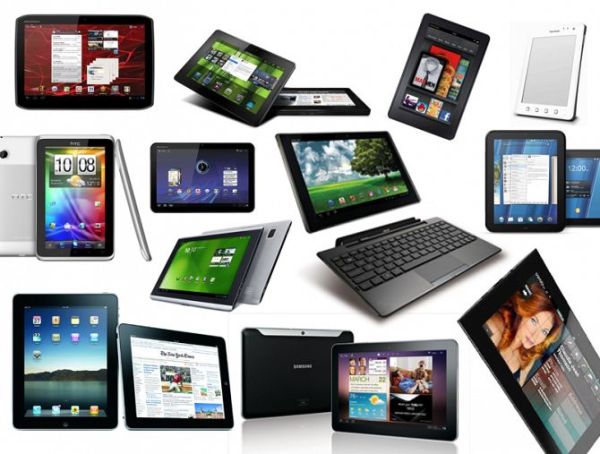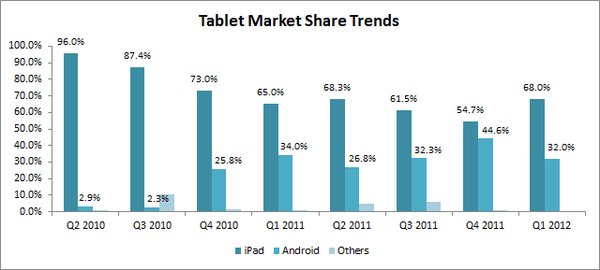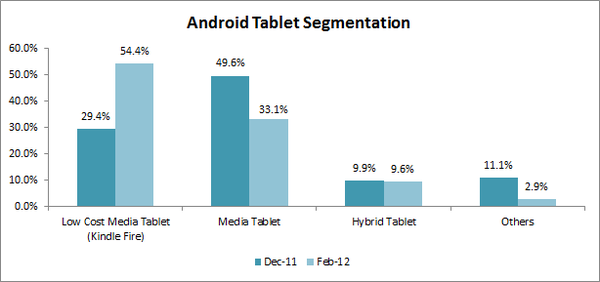Affiliate links on Android Authority may earn us a commission. Learn more.
Segmentation of the Tablet Market

This is a follow-up to my article, from a couple of months ago, analyzing the segmentation trends in the tablet market. Since I wrote that article, we have seen some more data on the market share trends of the iPad and Android tablets, including some very interesting data on the Kindle Fire. Now, let’s have a look at how the data stacks up against my predicted trends.
iPad vs. Android: Market Share Trends
Before I get into this, let’s have a look at the historical market share trends of the iPad and Android tablets over the past couple of years, in terms of quarterly sales.

This shows a fairly clear trend that the market is moving towards Android tablets and away from the iPad. In fact, this shows that the iPad has lost market share in every successive quarter in which there hasn’t been a new iPad launch. In Q2 2011, with the launch of the iPad 2, the Apple sales cycle gave the iPad a marginal boost in market share, which it again lost in the next quarter. Similarly, Android tablets seemed to have received a similar boost, in Q4 2011, with the launch of the Kindle Fire, which seems to have tailed off in Q1 2012 in advance of the new iPad launch.The tablet market’s Q1 2012 performance has been considerably muted, with a 38% decline in shipments. As per NPD, this seems to have been driven by build up of inventory during the holiday season, specifically for the Kindle Fire. This does not mean that the Kindle Fire was a flash in the pan. Rather, since we are tracking shipping figures, we need multiple quarters of consecutive QoQ data to get a good estimate of sales trends.
Even the iPad’s sales volume at 11.8 million actually came in under expectations. With the new iPad launched in March, it is possible that the iPad may temporarily make some more market share gains in Q2 before the major Android tablet launch in Q3.
The biggest threat to the iPad’s market share will be in the last two quarters of the year, with two major product launches – the Nexus tablet and the new Kindle Fire models. I’ve explained the reasoning for this statement in the section below. Hence, it makes sense to stick with my original prediction of Android’s quarterly tablet sales overtaking the iPad, in Q4 of this year.
Android Tablets: Segmentation Trends
Now, the section above gives us a good view of where the tablet market is headed, but it doesn’t really explain why. The key reason is market segmentation. A recent survey from comScore highlights the market share of Android tablet usage, among individual tablets, from December 2011 to February 2012. At first glance, it looks like the Kindle Fire has killed every other tablet, but there’s a little more to it than that.
First, let’s divide Android tablets into segments as follows:
1) Low Cost Media Tablet – Kindle Fire
2) Media Tablet – Samsung Galaxy Tab Family, Motorola Xoom, Toshiba AT100, Acer Picasso, Sony Tablet S
3) Hybrid Tablet – ASUS Transformer, Acer Iconia, Lenovo IdeaPad Tablet K1
4) Others – Dell Streak, Other (ComScore has included the B&N Nook Color here)
It is important to understand that since this data shows usage share, actual sales performance would be even more pronounced. Also, since the tablet market is growing at an incredible pace, constant market share implies the segment is growing at the same pace as the market, not a flat sales performance. Now, let’s have a look at this data again.

Now, these figures look a lot more interesting now. Let’s see what this means.
1) The two fastest growing segments in the tablet market are the low cost media tablets (Kindle Fire) and the hybrid tablets. This seems to be consistent with my prediction of segmentation trends in the tablet market.
2) As I’ve stated before, a low priced forked tablet is no guarantee to success, as the presence of the Barnes & Noble Nook Color seems to be minuscule. The key factors to a successful low cost tablet are acceptable content & good marketing push.
3) Most of the Kindle Fire’s gains seem to be at the expense of Media Tablets (since most of the tablets in “Other” would also be Media Tablets). Again, this is no surprise since the functionality offered by all media tablets is practically the same, albeit at different levels of quality. However, since the Kindle Fire is at an industry leading price point it has emerged as the winner. This is also the same problem the iPad seems to be facing.
4) This also highlights that there is plenty of room in the low cost media tablet segment for more competition. With the release of the Nexus Tablet and new Kindle Fire models, the presence of low cost media tablets will be strengthened even more and the primary victims will be other non-low cost media tablets (both Android media tablets and the iPad).
Conclusion
Looking at the trends highlighted above, it looks like the iPad losing the tablet market share crown by the end of this year is a likely outcome, with Apple’s current strategy.
Apple’s decisions over the next year will be very interesting to watch. It seems necessary for Apple to release a low cost 7.85″ mini-iPad, at the rumored $300 price point. However, this would have a significant negative impact on Apple’s profit margins, which is the primary factor driving Apple’s stock price.
Apple has already seen shrinking margins on newer iPad models because of its inability to raise prices, due to competitive pressure. Since hybrid tablets are more of a long-term play, Apple’s only other option is to retain the existing iPad and hope the market share loss can be contained. It looks like Apple may soon have to pick a lane in the margins vs. volume strategy, and either choice will have a long-term impact on Apple’s stock.